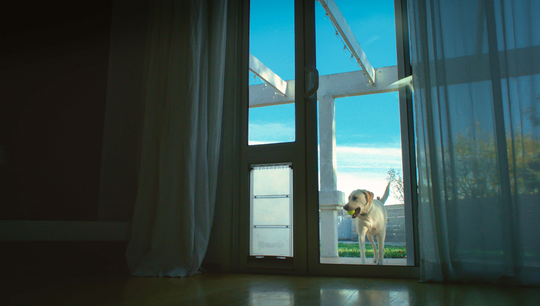Improving your pet’s quality of life starts with the installation of a pet door, whether it be in your back door or in your wall. But installing your pet door is only half the journey. Now, you have to train your dog and cats to use their brand new pet door.
Training your pets to use a new doggy door can be an exciting endeavor, offering them freedom and convenience, but it may come with challenges. Drawing from a wealth of insights and practical tips shared by pet owners and trainers, this guide is the ultimate resource to teach your furry friend how to confidently use their new passageway.

Understanding Your Pet's Perspective
For humans, pet doors are another mundane tool to help raise a dog or cat with an engaging, healthy lifestyle. However, your pets may think otherwise.
If this is your first pet door, this may be the first time your pet has ever seen a pet door before. Initially, your pet may view the doggy door with curiosity or even apprehension. Recognizing this, it's crucial to introduce the concept of pet door use gradually, ensuring the door is a safe and positive element in their environment.
The flap, in particular, may cause hesitation. Most pets experience anxiety if they cannot see where they are going. If you have an opaque flap, you should start with it opened or removed until your pet can get used to it.
However, some pets never get used to opaque flaps. That’s why it’s crucial to have a flap that is completely see-through, such as the clear flap on the Liberty Pet Door. With it, dogs and cats can see what is on the other side of their door easily.
Not only will it be easier to train them to use their pet door, but the Liberty’s clear flap is the safer option as well. Being able to see what’s on the other side of the flap will prevent them running through the flap and slamming into an unseen obstacle.

Creating Positive Associations With a Dog Door
A key component of any training regime is to create a positive association around what you want your dog to learn to do.
Use treats, toys, and plenty of praise to build positive associations with the doggy door. Start by placing these incentives just beyond the door, which can not only pique your pet's interest, motivating them to venture through the opening, but also reinforce that using their pet door is rewarding.
This positive reinforcement should be consistent, rewarding each successful passage through the flap until your dog is a confident pet door user.
Incremental Training Steps For Training Your Dog To Use Their Dog Door
Training your pet to use a new doggy door involves a series of incremental steps that will gently acclimate them to this brand new way of getting in and out of the house. You will first need to familiarize your pet with their door before playfully introducing it to them before finally desensitizing them to the flap itself.
To train your pet, you will first need to familiarize your pet to the doggie door by allowing them to explore it at their own pace. At this point, it’s helpful to remove the flap or to keep it propped open, especially if the flap isn’t see through. Keeping the flap open reduces any initial fear or hesitation your pet might experience otherwise.
Allowing them to sniff, inspect, and walk around the door without the flap encourages curiosity and helps them understand that this new pathway is safe and accessible.
Next, you should playfully introduce your pet door by incorporating toys and treats, which will make interacting with the pet door fun and rewarding.
For example, you might place their favorite toy or a trail of treats through the open doorway to encourage them to pass through it. This method not only draws their attention to the door but also creates a positive association with it. The aim is to have your pet link the doggy door with positive experiences, thereby increasing their willingness to engage with it further.
Once your pet is 100% comfortable with the concept of a dog door, you can introduce the flap—this phase is known as flap desensitization.

Start by gently moving the flap slightly in your pet's line of sight to get them accustomed to its movement and sound. This is vital if your pet door has any magnets on the flap as the magnets can make a loud noise when the flap is used.
Every time your dog successfully uses their door or even approaches the flap, reward them with treats or praise. Gradually, you can increase the flap's movement, encouraging your pet to touch or push it lightly.
The goal here is to ensure your pet understands that the flap is not a threat and that interacting with it leads to positive outcomes. From here, make sure your dog goes through the pet door flap for regular activities, such as going to the bathroom or going outside to play.
Overtime, you will be able to reduce supervision and trust your dog to use the pet door on their own.

Quick Tips for Training Your Dog To Use a Pet Door:
When teaching your dog to use a pet door, here are some key tips to keep in mind:
- Start with Simple Beginnings: Hold the flap of the pet door open and use treats or toys to lure your pet through. Offer plenty of praise and rewards for each successful passage.
- Increase the Challenge Gradually: Once your pet is comfortable with the open flap, start to lower it so they have to push through slightly. Use gentle encouragement to help them understand what to do.
- Practice Entering and Exiting from Both Sides: It's important for your pet to be comfortable using the door from both inside and outside. Reinforce their success with treats and praise each time they pass through.
- Introduce Distractions: Place treats or toys outside the door to motivate your pet to use it independently, without your direct involvement.
- Incorporate the Pet Door into Daily Routines: Make use of the pet door for regular activities, such as going out for walks or potty breaks, to help your pet understand its purpose.
- Reduce Supervision Over Time: As your pet becomes more confident, gradually reduce the amount of guidance and supervision you provide, allowing them to use the pet door at their own pace.

What Do I Do If My Dog Can’t Learn How to Use a Pet Door?
It’s alright if your dog doesn’t get the hang of their pet door right away. Change takes time, and dog training is a game of patience. Here are some tips if you need help troubleshooting:
- If your dog is stuck on a step, don’t be afraid to backtrack to earlier steps in the process! Doing so will help to reinforce their dog door as a positive experience.
- Your dog will have trouble using their dog door if it’s not the right size. Make sure you got the right pet door, and don’t be afraid to upgrade to a different size if needed.
- If the magnets on your pet door are too loud, try softening them with duct-tape. You can remove the tape once your pet is used to using the door.
- If your dog is having a really hard time learning to use their pet door, then consult with a professional trainer can provide tailored advice and strategies.
Celebrating Independence
Training your pet to use a doggy door is a journey of patience, consistency, and positive reinforcement. Celebrate each milestone, understanding that each pet's learning pace is unique. With time, your pet will enjoy the freedom and autonomy provided by the doggy door, offering peace of mind and convenience for you both.
Embrace the training process with enthusiasm and understanding, and soon, your pet will be navigating their new doggy door with confidence and ease.



